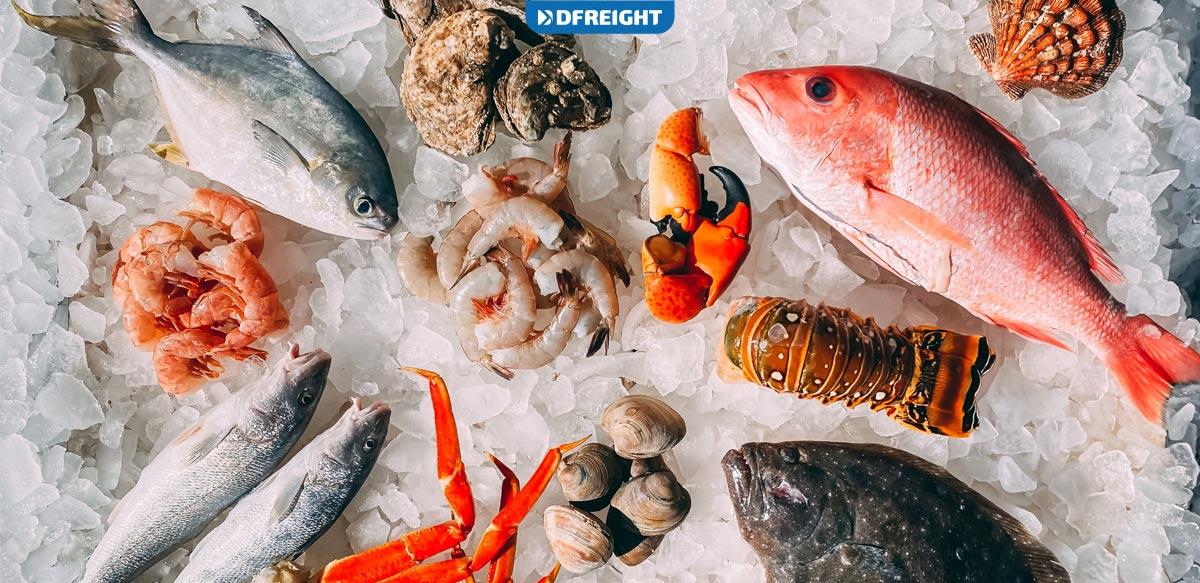Seafood freight can be risky and challenging for freight forwarders, necessitating special equipment and arrangements. The fish and seafood markets are booming, and demand for these commodities is increasing. Seafood is a good source of quality protein and vital nutrients and should be in your family’s diet. Seafood includes pelagic fish, demersal fish, freshwater fish, scallops, shrimp, lobster, caviar, salmon, prawns, crabs, mussels, clams, oysters, shellfish, and other types. Seafood freight transportation is safe if all the aspects of proper transportation are considered during the process.
The transfer of seafood must follow strict guidelines. The criticality of adequately delivering these foods is one of this section’s challenges. In seafood freight, the use of different transportation methods is somewhat limited, as it is impossible to utilize methods that take a long time. Let’s start by recognizing regulations and factors necessary in seafood freight.
DFreight is the freight forwarder you can trust to get your seafood products to market quickly and safely. We have a team of experienced seafood industry professionals who know how to handle your seafood freight carefully. Get a free quote today to get started.
Table of Contents
Demand for Seafood
Rapid growth and development, coupled with the rising consumption of seafood, are likely to be the primary factor driving the fisheries and aquaculture. The United Arab Emirates, with a population of 10 million and a median age of 33.5, is a good market for seafood freight.
The demand for fish and seafood is increasing among consumers, as it is high in nutrition and low-fat protein. The rise in meat consumption, growing health concerns, changing diet patterns, urbanization, population, and economic growth influence the higher preference for seafood freight. The United Arab Emirates is the highest consumer of fish among all GCC countries, with most of the population preferring seafood.
According to the United Arab Emirates Ministry of Climate Change and Environment, in 2017, the average annual seafood consumption in the United Arab Emirates was nearly 226,000.0 tons, while the UAE’s fish stocks were 70,000.0 tons, forcing the country to be import-dependent for more than 70.0% of its seafood.
Mordor Intelligence
Types of Seafood Freight and Shipping
The seafood freight industry is a vital part of the economy in many coastal communities. Seafood freight is typically shipped live, fresh, or frozen. Live seafood is the most delicate and requires the most care in shipping. Fresh seafood is less delicate but still requires careful handling to preserve quality. Frozen seafood freight is the most forgiving, but proper handling is still necessary to avoid freezer burn therefore, study carefully about how to ship frozen food overnight. Seafood is typically shipped by air, rail, truck, or sea.
Air is the quickest and most expensive method, but it is necessary for live seafood freight. Rail is less expensive than air but is also slower. The truck is the least expensive option but the slowest. The boat is the slowest option but can be the most cost-effective for large shipments. The type of packaging used is also essential. To prevent stress and death, live seafood freight must be packed in oxygen-rich water. Fresh seafood freight must be packed in ice to keep it cool. Frozen seafood freight must be packed in dry ice or gel packs to keep it frozen.
The seafood industry is highly regulated to ensure quality and safety. There are strict guidelines for shipping live, fresh, and frozen seafood that must be followed to avoid costly delays and penalties.
Regulations of Seafood Freight
The seafood freight industry is one of the most critical industries in the world. It is responsible for transporting seafood from one place to another. Seafood freight is very delicate, and many regulations and cautions must be followed to ensure that the seafood freight is properly transported. Here we review some of the regulations:
- Proper refrigeration: If seafood freight is not adequately refrigerated at a temperature below 40 degrees Fahrenheit, it can spoil and become dangerous to eat.
- Packaging: All seafood must be properly packaged to prevent it from being damaged during transport, allowing it to breathe but not too tightly.
- Contamination: Seafood freight must be transported clean and sanitary to prevent contamination.
- Inspection: Before being transported, all seafood must be inspected. This means that the seafood needs to be tested for quality and safety before it is transported. A trained inspector is required to inspect the seafood freight.
- Delivery: To avoid food safety risks, all seafood must be delivered on time.
- Freight vessel: All seafood must be transported in an approved container, typically made of stainless steel or plastic.
- Labeling: All seafood must be labeled with the correct name, address, and telephone number of the seafood supplier, the date of catch, the type of seafood, and the country of origin.
- Insurance: The cargo must be transported in an insured container to be protected against loss or damage.
- Periodic checking: The cargo must be transported in a regularly inspected container by a qualified inspector.
- Hygiene: Seafood freight must be transported in a clean container free of debris or foreign objects.
- Safety: Seafood freight must be transported in a container free of any chemicals that could harm the seafood freight. Also, they must be transported in a container free of any flammable or explosive materials.
When employing modern equipment, there is no need to be concerned about seafood freight. The use of appropriate equipment refers to equipment that complies with the storage conditions for seafood, which vary depending on the species. The general condition is to observe aspects that keep seafood fresh or alive if needed. Overcrowding of marine species in a single enclosure should be avoided. Some species are temperature-sensitive, and the storage area’s temperature must be carefully controlled.
Based on marine species, determine the pH and salinity of the water as well as the humidity of the environment. It should be noted that when it comes to fish and seafood live transport, it is important to keep their conditions stable and prevent them from feeling different from their previous living environment because being stressed caused by changes in the environment can cause losses in your load.
Considering these conditions, you can move your seafood freight by sea, air, or even by road. It should be noted that the paperwork and cost of doing this process take a little longer than for other shipments.
Suppliers
In the United Arab Emirates, imported seafood accounts for over 70% of total demand. China and Norway are the leading countries in seafood production and export. The United Arab Emirates intends to breed these species to suit the country’s needs rather than merely importing them. As a result of the UAE’s investment in this sector, a Norwegian team has been dispatched to the country to build the necessary equipment and prepare for the country’s self-sufficiency. This cooperation is one of the achievements of Expo 2020.
In 2021, Norway exported 3.1 million MT of seafood products worth NOK 120.8 billion (USD 13.7 billion, EUR 12 billion), the highest-ever trade volume and value totals achieved on record.
seafoodsource
Conclusion
Seafood is a delicious and healthy option for many people, but it can be difficult to ship without the proper knowledge. Luckily, with a little planning and research, it is possible to use seafood services safely. By following these tips, you can ensure that your seafood arrives fresh and delicious.
DFreight Services
Here at DFreight, we offer you the best and most reliable methods of seafood freight. With these services, you may get into the booming maritime industry with the least risk.
What is the most popular seafood product in the UAE?
The most popular seafood product in the UAE is salmon.
What is the growth rate of the United Arab Emirates Fisheries and Aquaculture Market?
The United Arab Emirates Fisheries and Aquaculture Market is growing at a CAGR of 4.7% over the next five years.
What are the seafood transport vehicles?
Any vehicles can be used for this purpose as long as the environment is clean, the temperature is suitable, and food contamination is avoided.
How do I track my seafood shipment?
You can track your seafood shipment by using the tracking number provided by the shipping company.














